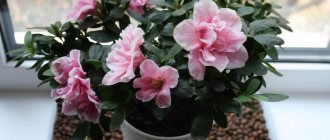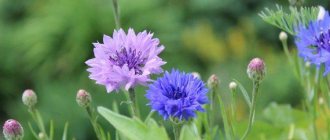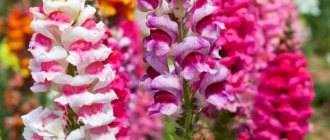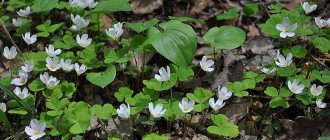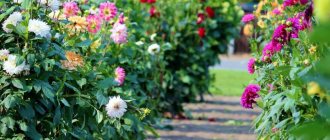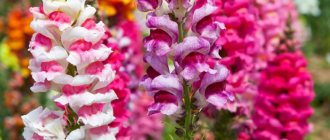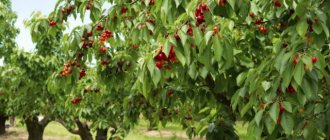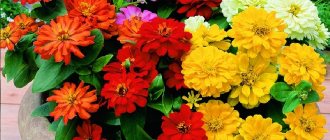Previously known to everyone exclusively as a wildflower, cornflower subsequently took on a cultivated form and settled in many flower beds as an ornamental plant. And its various varieties today boast more than just shades of blue.
Garden cornflowers have one difference visible to the naked eye from meadow plants of this species: they are decorative and are distinguished by larger flowers. And most importantly: the rich blue shade of the buds, which is familiar to us, has been replaced by a variety of colors of cultivated species and varieties. By the way, among the inhabitants of flower beds there are also cornflowers, which are radically different from the original even in the appearance of the flowers: they are denser and fluffier, and we will also tell you about them.
There are two versions of the origin of the word centaurea - the Latin name of the plant. One of them, mythological, claims that with the help of cornflower the centaur Chiron was healed from the poison of the Lernaean Hydra. Another says that this flower was called that way even under Hippocrates, and translated from Greek its name literally sounds like “stabbing bulls.”
Classic Fantastic
An annual or biennial flower in cool blue shades, from light sky and blue to dark blue, as well as two-tone blue and white. Grows up to 100 cm in height and up to 30 cm in width. Unpretentious to grow. Looks especially good in borders and as part of a Moorish lawn. Flowering is abundant and long lasting - from June until frost.
- Low-growing plants for hedges and borders
Emphasize the beauty of the landscape with a low hedge up to 1 m high.
Cornflower petals of some varieties (for example, Classic Fantastic) are used in cooking - added to salads, sprinkled on omelette or pasta.
Features of reproduction
Annual varieties are propagated by seeds. You can purchase them at the store or prepare them yourself by drying the seed pods. The extracted seeds are stored in a cool, dry place, placed in thick paper bags.
Attention! Annual double cornflowers grow greatly during the season. Many gardeners have a desire to divide the bushes. This is not worth doing. Flowers very rarely take root.
Perennial double cornflowers can be propagated by dividing the bushes.
John Coutts
Large pink or purple flower with a white center. Capable of growing up to 50 cm in height and width. The plant is rich in pollen, so it performs an additional function by attracting living helpers - bees - to your site. Perennial, frost hardy, ideal for mixed herbaceous borders, gardens or containers where it will bloom continuously from June to September.
- DIY container garden - 6 tips for creating and maintaining
A landscape designer from Belarus shares his personal experience in creating an unusual container garden.
It is best to grow this cornflower in well-drained soil in a sunny or partial shade location. And if you regularly remove wilted leaves and stalks, you can sometimes prolong its flowering. By the way, this is also true for some other varieties of cornflowers. Does not have toxic effects on people and animals.
Outdoor care
Cornflowers are planted in a well-lit, open place. Slight shading is allowed. The soil should be light and loose. Loams or sandy loams are suitable. If necessary, add sand to heavy soils.
Daily care is very easy. It comes down to infrequent watering, only in the absence of precipitation. Cornflowers tolerate drought well, but they suffer greatly from stagnation of water in the soil.
Once or twice a month, plants are fed with a mineral complex (20-30 g/m²). Well-diluted fertilizer is poured into the soil at the roots. If you apply too much fertilizer, the foliage will begin to turn yellow and dry out.
In order for the vegetation to have an attractive appearance, faded flowers should be removed in a timely manner. You can limit yourself to removing only the inflorescence itself and leaving the shoot intact, but it is better to cut it to a height of 10 cm above the ground. Then the growth will be more neat and dense.
Plants do not need shelter for the winter. Annuals are simply cut and dug up in the area. And perennials are cut back to the ground. The remaining shoots will dry out, and in the spring new shoots will sprout from the roots.
Cornflower gets sick very rarely. This can happen if the location is too shady and damp. Then fusarium develops on the shoots. Treatment with a fungicide will help correct the situation, but it is better to carefully follow agricultural practices. At high temperatures and dry air, cornflowers can be attacked by spider mites. Get rid of parasites using a solution of soap or insecticides.
Amethyst in Snow (Amethyst in Snow, Amethyst in the snow)
The Amethyst in the Snow cornflower is a bicolor flower with silky white tube-shaped petals that emerge outward from a sharp purple center. It can grow up to 50 cm and in width up to 1 m.
This cornflower gets its interesting name because its core is actually similar in color to the amethyst gemstone. And the white petals surrounding it resemble snow. Literally translated into Russian, the name Amethyst In Snow means amethyst in the snow. The plants form dense masses, which makes it an integral part of any flower garden - edging, mixborder, front garden or rock garden.
For best flowering, this cornflower is grown in an open sunny area in neutral or alkaline soil with good drainage. The plant requires division every 2-3 years. Its flowering occurs at the end of spring - beginning of summer. This means that it is advisable to plant nearby plants that bloom throughout the season or arrange a flowerbed of continuous flowering.
- How to beautifully decorate a flowerbed of continuous flowering with your own hands
Popular flowers for flower beds that bloom all summer, photos for inspiration, as well as colorful diagrams and useful recommendations!
Types and varieties
Among all the varietal diversity, several of the most beautiful and popular options among gardeners stand out.
Annuals
The main wild form is also known as blue, blue or field cornflower. Among the cultivated varieties in gardening, the most common are Black ball, Blue diadem, Florence pink.
Important! Sowing annual flowers: sowing calendar, growing rules
The main representatives of cultural forms of musk species growing in nature are Bride, Morgan.
Related article:
How to plant ranunculus
Perennial
Wild varieties such as Russian, Fisher, large-headed and soft have no cultivated ornamental varieties.
The popular cultivated form of whitened cornflower is called John Courts, the mountain one - Alba, Grandiflora, Parham, Rosea, Violetta.
Bride (Bride)
An unpretentious annual with large fragrant white flowers. This stunning snow-white cornflower is ideal for cutting. Its height is 60-100 cm, and the diameter of the flower is about 30 cm. In the strict sense of the word, it is not even very similar to the traditional cornflower. And only the characteristic structure of the flower indicates that it clearly belongs to the Asteraceae family.
The tubular flowers are very elegant due to the deeply cut edges of the corolla. An ideal “candidate” for a place of honor in any bouquet, it will, however, be able to decorate any flower bed on your site, especially since it blooms from May to July.
- What types of flower beds are there?
What is the difference between a flowerbed and a front garden, and a rockery from an alpine hill?
To increase the splendor of the plant, it is necessary to periodically pinch it.
Application of Cornflower:
The cornflower flower is used in cooking. Its leaves have a delicate aroma and are often used as a seasoning for dishes.
Medicine has not been spared cornflowers either. This flower has diuretic properties. Therefore, cornflower decoctions are used for kidney diseases, edema, etc. Cornflower decoctions also have choleretic properties. It is also used for liver diseases, including jaundice. Cornflower also has antipyretic, diaphoretic and bactericidal properties.
The flower is often used in cosmetics. Cornflower is also in demand as a decorative flower. Cornflower is also mentioned as a dye for Easter eggs. But in our time, when food dyes are available, it is unlikely that people will run into the field for cornflowers.
Frosty
A multi-colored, unpretentious annual up to 80 cm high. Delicate double flowers are collected in inflorescences shaped like baskets. Frost-resistant, prefers sunny places and well-drained soil with a neutral acidity level. The plant is drought resistant.
Frosty's cornflower gets its name from its white border, which, when viewed from a distance, gives it the appearance of a frost-covered flower.
Looks great either cut as part of a bouquet or in any flower bed. Blooms from June to September.
How is the plant used?
To create medicinal preparations, all parts of plants are used - stems, leaves, inflorescences, roots. They are used to make infusions, herbal baths, they are brewed and steamed, and used in dried form. In cosmetology, where meadow cornflower has also found its application, it is used in cosmetic masks, and infusions are used as lotions. Below is a description of some cosmetic and medical preparations based on it.
In medicine
For sprains and aching bones, a poultice from the cut off ground part of cornflower is used. Harvested plants, preferably freshly harvested, are treated with boiling water, wrapped in gauze, and the resulting hot poultice is applied to the source of unpleasant sensations. For cardiovascular, kidney and colds, the infusion is used. It is made simply: pour 2 teaspoons of the dry plant with a glass of boiling water, leave for a couple of hours and strain. The resulting drug is consumed one tablespoon three times a day a few minutes before meals.
An infusion of dry roots helps with diarrhea. It is made similarly to the previous one: 2 teaspoons per glass of boiling water, 2 hours of infusion and straining. Take in exactly the same quantities before eating.
In cosmetology
Cosmetic masks made from cornflower have a positive effect on the condition of the skin. To make it, take 3 tablespoons of dried flowers and pour 100 ml of boiled water, cooled to +80–90 °C. The container with infused flowers is covered with a lid and left to cool. After this infusion has cooled, it is mixed with 50 g of liquid honey. The mask is applied to clean skin and left for 20 minutes. Cornflower infusion is also used as a lotion. For preparation you need 2 tablespoons of dried flowers. They are poured with a glass of slightly cooled boiling water, kept under the lid until completely cooled and filtered. The resulting infusion is used as a regular body lotion. It is applied to the skin once a day. You can also freeze the infusion in molds. The result is so-called cosmetic ice, which is also used for daily wiping of the skin.
An infusion of cornflower is also used as a remedy to relieve swelling and redness of the eyes. To do this, use a tablespoon of dried flowers per glass of boiling water, cooled to +90 °C. After the infusion has cooled to room temperature, it is applied to the eyelids with a cotton swab. The procedure lasts approximately 20 minutes.
In other areas
In addition to medicinal and cosmetic uses, meadow cornflower is known as a good honey plant. In terms of productivity, it, of course, looks rather pale compared to such champions as acacia or linden, but it pays bribes over a long period. Its productivity is estimated at 100–130 kg per hectare in terms of continuous tracts of this flower.
Article on the topic: Ortilia lopsided - useful properties, description
The plant is also used to feed livestock. In addition, it is sometimes used as a decorative plant when decorating flower beds and flower beds.
Black ball (Black Ball, Black ball)
An annual plant with burgundy-violet (sometimes chocolate) flowers. Grows up to 75 cm in height and up to 30 cm in width. This cornflower is recommended to be grown in moist, well-drained soil in an open, sunny location. Blooms from June to August. You can extend this phase by immediately removing the dried stalks.
Blackball cornflower is so rich in nectar and pollen that it will attract beneficial beetles and other insects, as well as birds, to your garden.
- 7 beetles that every summer resident should take care of
Before squashing a beetle that comes into your field of vision, examine it carefully. Perhaps this is one of those who protect our gardens and vegetable gardens from pests.

